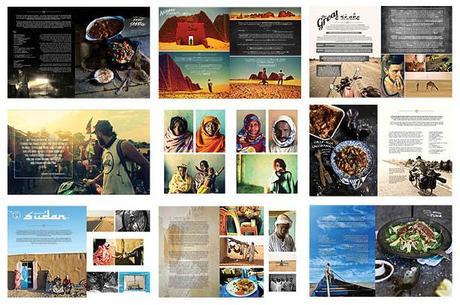
Tom Perkins and Matt Chennells embarked on what they would describe as an epic culinary adventure. Words like “epic” get tossed around often nowadays, but when you consider that they journeyed from London to Cape Town on just their bicycles, traveling a distance of over 12,000 miles in 501 days, “epic” is the most accurate word to use.
They wanted to challenge their endurance. They wanted to learn about and more richly experience different cultures. They wanted to enjoy delicious food from a variety of regions.
Tom graciously took some time to discuss this trip and the cookbook that chronicles it with me. Click through to read our interview, view photos and videos previewing the project, and find links to his Kickstarter page and website.

What inspired you to travel the globe and compile a cookbook about foods you tried during your adventure?
The original idea to do this trip came about through little more than a throwaway comment, which quickly snowballed into what it became. After four years of varsity, my best mate and myself were both very keen to explore those areas of the world which we had studied but only had surface level, academic knowledge of. We wanted to travel in a way that would be both constructive and relatively unique. We were also motivated by the prospect of an adventure that would challenge us physically. One that would maximize the benefits of unhurried passing. The implications of a meager budget also played a pretty major role.
So the idea to journey from one home to another was told to one friend and then another; and then largely by accident we had told too many people not to be held accountable to our word. The bicycle component came after many other modes of transports had been ruled out for various reasons. The idea of creating a travel cookbook was one of the very first things that I came up with during the initial planning phases of the journey. Over a journey that spans 501 days, having certain ongoing projects helps maintain focus and motivation – this was mine.
You write that a pink guitar was one of the heavy and useless things you brought along with you. Name some other slightly odd items that appeared in your luggage.
The pink guitar, affectionately christened Ruby, was a serious contender for the most aerodynamically obnoxious piece of equipment we lumbered about. A comically heavy metal wok sourced from the back streets of Dar es Salaam, Tanzania, could stake a good claim for the most weighty piece. Two large camel hair rugs bought from a Bedouin in the middle of the Egyptian desert certainly didn’t lighten the load, but added to nocturnal comfort. A solar powered toy dung-beetle, named Dennis, was slightly strange but became somewhat of a mascot for the journey.
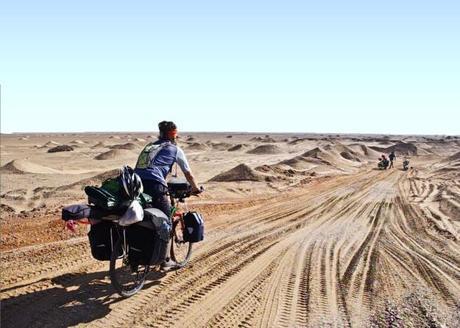
How did you convince your friend Matt to accompany you? What role did he play in the journey? What did he contribute to the book?
My convincing went something along the lines of, “Matt, do you fancy it, mate?” There wasn’t even the slightest hesitation from him. From the very first moment, we thrived off each other’s enthusiasm for what lay in store. Very importantly, our overall goals and the manner in which we sought to achieve them were perfectly in sync. There simply was no journey without him.
Human nature revolves around interaction, and having your best mate with you through so many defining moments, sharing both the good and the bad times, is a wonderful privilege. These times are guaranteed to come about on a journey like this, and there was absolutely nothing but resolute support and understanding from Matt during some of the more challenging moments. Matt’s contribution and attitude to the book is the same as his attitude towards anything – one of unquestionable encouragement.
How did your traveling crew grow from two to four?
During our journey, we were running a blog that we would use to keep people updated with our stories, movements, and as a sign that we were still alive. Two great mates from varsity days got in touch with us; it seemed that the lure of trans-continental bicycle adventuring resonated pretty strongly with them too. We said where we would roughly be, giving a rough date, and they jumped right in. Jimmy flew into Khartoum, Sudan, and Buster into Addis Ababa, Ethiopia. They brought incredible excitement and fresh motivation, and immediately became integral cogs to the rag-tag tribe we became.
How did you return home once you completed your trip?
The return home was a very surreal feeling. My grandmother passed away a few days after we had completed the trip and so I had to fly home for the funeral. Retracing the distance that had taken us seventeen months to navigate, but now in the space of only 11 hours, was a bizarre concept. Looking down and seeing these great open expanses below give a sense of real pride, scale, and also confusion. It certainly took a long time to fully digest and then comprehend when we had done. Readjustment requires suitable patience.
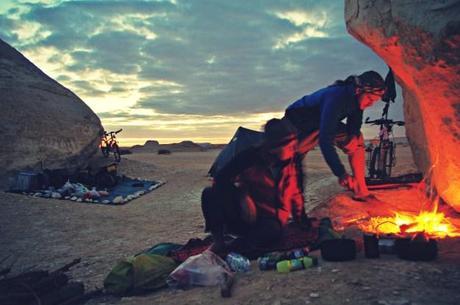
Aside from the recipes, what does the book consist of? How is the other content formatted and integrated with each culinary region?
The format of the book is a synergy between a traditional recipe book format and a narrative driven travelogue. The reader is given an anecdote based upon an engaging travel experience; these vary in length between 1-4 pages. It might be the experience of traversing the Alps, crossing the Sahara Desert, or traveling along the Rift Valley during the monsoon. Many of these anecdotes then lead on to the introduction of an individual that either helped or significantly influenced the progress of the journey. The following 1-2 pages then show this character sharing their favorite recipe, or a recipe that is common and popular to their culture, with the reader.
This multi-faceted approach results in a cookbook that hopefully appeals on a number of different levels. Firstly, as an instructive and informative recipe guide. Secondly, as a travel journal that allows the reader to vicariously partake in an ambitious, unique culinary journey traveling alongside two young guys and sharing in the many highs and the lows of the adventure. Thirdly, as an unusual and rare insight into some of the world’s most diverse and least documented food cultures.
The narrative pages follow chronologically with the progress of the adventure and are heavily illustrated with awe-inspiring pictures taken en-route the 501-day journey. A recipe taught by a passing Bedouin in the middle of the Jordanian desert is consequently enriched by the situational and of-the-moment photography that captures that particular scene; this adds to the authenticity and appeal of both the culinary and the travel experience.
Your book has a beautiful video trailer. Do you intend to release any other videos to accompany the content of the book?
We tried to document the journey as comprehensively as possible. There are other videos that we put together whilst on the road and that will be subsequently re-edited. These will hopefully be included within the interactive e-book. However, because of the nature of the trip, we did have a few problems with sand and dirt getting into cameras and causing them to break down at times. We do have plenty of footage; it’s now a case of putting it all together comprehensively. The trailer hopefully gives a vivid sense of mood and get viewers excited about the imagery.
Your book seems to have evolved into a story about the good of humanity. Expand on this; give some condensed examples of the generosity others expressed and the people you encountered.
The success and real value of a trip such as this is not only enhanced by, but rather completely dependent on, the personal sacrifices and generosity of complete strangers. We had huge amounts of emotional and practical support at every stage of the journey, immeasurable and unrelenting and from people that had no idea who we were or what we were doing.
During some of the lowest and most problematic of times, when our progress seemed so untenable, we were aided and motivated by people infinitely wiser and more level-headed then ourselves. It’s impossible to put a figure on the number of households and communities that welcomed us into their lives and put all their energies into simply helping us.
In central Turkey, we were welcomed into a home and introduced to a room full of extended family. Everything was put on hold while the family made sure we were fed, watered, showered, and tended to wholeheartedly. Only later that evening were we informed that when we had arrived at the home we had done so in the middle of their uncle’s funeral. In Khartoum, Sudan, I was welcomed into a stranger’s home. I only left a month later. Time and time again we were exposed to the purest and most complete expressions of unconditional giving. Nothing was ever too much.
I could give a hundred more examples of pure kindness, but to start singling out just a few (despite having done so already) would be to underplay the significance and appreciation we had for every single act bestowed upon us. This really was a trip about being vulnerable, and through that vulnerability being exposed to the very raw goodness of humanity.
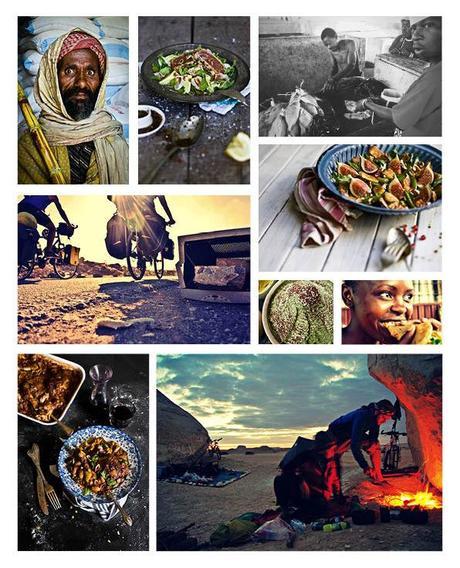
What do you envision for the future of your book? What mark do you aim to make?
We realize how lucky we were to have undertaken such an adventure and feel strongly motivated to preserve, reflect, and share. This book is our way of saying a meager but much-appropriate thank you to a large collective of exceptional people.
We never were, and certainly still don’t consider ourselves cyclists – which just goes to show that this sort of travel really can be done by anyone. If you can come up with an idea, no matter what size or ambition, but one that truly excites you, then you are well on your way. Then find a method and a means that best suits your own objectives, surround yourself with people that are unconditional in their belief and support, and fully commit yourself to achieving those ends. The last and hard part is just starting; be flexible and open to the inevitability of problems and the evolution of goals, put faith in the inherent goodness of strangers. And importantly – never lose sight of perspective.
If the documentation of our journey, our experiences, and our commitment to a passion comes across in this book and it makes people happy reading about it, then all ambitions have been well and truly met. If it spurs just one person out of their comfort zone and gets them inspired to also start their own dream journey, then that would be an amazing marker of success.
Your Kickstarter profile says: “SPICES & SPANDEX is his first publication under ‘The Nomadic Kitchen’ brand. This will not be his last.” What else do you have in the works? Could you give us a sneak peek?
I tend to stare at maps quite a lot and always own a globe – this leads to a lot of scheming about what, where, and how to do the next adventure. The itch of wanderlust seems pretty insatiable once you have done your first big journey. Buying a clapped-out old rickshaw and converting the back into a mobile kitchen & camping unit will certainly be the next mode of transport. Where? Maybe Western India to Vietnam. Or Buenos Aires to Buenos Aires via a big round loop of South and Central America. I like to pick a start point and a finish and then plan very little after that. Let circumstance take over from there.
The Nomadic Kitchen is driven by a simple aim – to travel to the furthest and most remote corners of the world using wholly unconventional machines, following the rumblings of a hungry stomach. If people like what’s in the first book and get excited about the concept of adventure travel cookbooks, then I’ll plan, save, and work as hard as I can to make the next one possible.
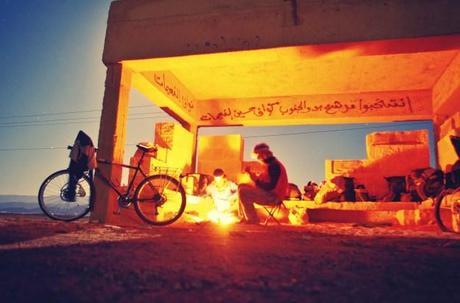
If you feel inspired to support him, head over to his Kickstarter campaign! There is a set price for a copy of the print publication, but there are rewards for every level of funding, such as a copy of the cookbook in ebook format, your name listed on the thank-you page in the book, or even a limited edition gift box full of exotic spices used in the recipes!
Please note: Pledge levels are in £ (pound) amounts, not $ (dollar) amounts.
Tom can be found elsewhere on the web at his website, Facebook page, or YouTube channel. Follow him on Twitter @nomadickitchen.

